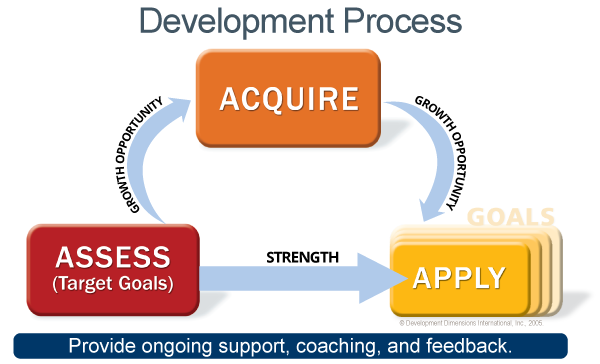We all know that time is not our friend; it’s a scarce commodity. Leaders have 480 minutes in their workday, and it’s always difficult to decide what to take on and what to defer. And even though many organizations have lofty goals for leaders to make time for development, leaders often struggle to fit it in with all their other competing responsibilities. On top of this, teaching leaders how to take ownership of their learning can be an important step that organizations either all together miss or struggle to do well.
For example, some organizations set up a library of leadership development content and expect leaders to self-study with little to no buy-in from the leader and little to no management support or reinforcement. It’s no wonder that results from these development efforts are disappointing to say the least.
This situation reminds me of the proverb, “Give a man a fish and you feed him for a day. Teach him how to fish and you feed him for a lifetime”
How hard can it be to teach leaders to take ownership of their learning and development (or, to go along with the analogy, how to fish)? There are a few barriers to overcome. The first is ensuring your leaders understand the importance of their development and how it relates to the goals of the business. Making this rational case for why can make it easier for them to want to learn. You also need to create and maintain the right conditions for them to be able to learn; make it too difficult and they’ll quickly lose whatever motivation and ability they had.
Having the right mindset going in is key
Another challenge is to make sure your leaders have a growth mindset. An individual’s growth mindset is best defined by comparing it with a fixed mindset as described by Carol Dweck in her 2007 book, Mindset:
“In a fixed mindset, people believe their basic qualities, like their intelligence or talent, are simply fixed traits. They spend their time documenting their intelligence or talent instead of developing them. They also believe that talent alone creates success—without effort.”
Contrast this with Dweck’s definition of a growth mindset:
“In a growth mindset, people believe that their most basic abilities can be developed through dedication and hard work—brains and talent are just the starting point. This view creates a love of learning and a resilience that is essential for great accomplishment.”
Hiring or promoting leaders with a growth mindset is an essential first step (but not part of this blog), because everything that follows is directly impacted by the leaders’ mindset.
4 learning styles of leaders
It’s also important to accept that leaders differ in how they prefer to learn. Learning styles of leaders can be grouped under four headings:
- Thinking alone, where leaders study, observe, and plan before undertaking a new activity.
- Thinking with others, which means getting people’s ideas before trying something new.
- Acting alone by plunging into a new activity independently rather than studying it in advance.
- Acting with others, where leaders act rather than contemplate when learning new things, relying on people for feedback and advice.
Understanding the various learning styles of your leaders can help you get to their specific learning needs. We’ve also done research on the learning preferences of leaders that can help inform some of the key decisions that have to be made surrounding your company’s leadership development efforts.
According to DDI’s 2018 Global Leadership Forecast (GLF), there are 19 learning methods for developing leaders, but are these the correct methods? The GLF asked learners what they needed to help them learn. The data showed that consistently across the generations the learners preferred:
- Personalized learning experiences
- Coaching from external mentors
- Formal workshops, training courses, and seminars.
But the reality is that what they often get in terms of learning methods can be very different from what they want.
How to teach people to take ownership of learning
Coming back to our fishing analogy; how is this approach to learning going to set the leader and the organization up for success going forward?
There is a three-step process for teaching leaders to take ownership of their learning. A key to self-sufficiency is to provide the appropriate levels of development, enabling them to capitalize on their motivation to learn, their understanding of how they learn best, and their needs.
In DDI’s development process, leaders are introduced to the assess, acquire, and apply phases:

Assess enables leaders to identify skills, knowledge, or abilities that are strengths or growth areas. By narrowing in on their strengths and gaps and formulating a specific development goal for each, leaders will be better able to focus on areas that will move the work forward, build future potential, and meet key job responsibilities.
Acquire is when leaders plan how to obtain the chosen skills, knowledge, or competencies. Remembering the learning styles of your leaders and their specific needs can help you identify the learning methods that will help them learn best. The second part of acquire is actually learning the skills. The best results occur when a combination of learning approaches is used. It’s also important to identify possible barriers during this phase that could prevent or hinder learning, and then be prepared with support or resources to help leaders avoid or overcome these barriers.
Apply is where leaders identify opportunities to use newly acquired skills, knowledge, or competencies. Many of these can be found in current job responsibilities or future projects. Make each application opportunity progressive; that is, incrementally build skills to enhance competence and boost confidence. Set measurement methods to gauge progress and outcomes. Identify possible barriers as well as support or resources needed to successfully apply the skills.
Best practices for sustaining learning
All this good work may come to nothing unless the organization maintains an environment that sustains appropriate levels of support, coaching, and feedback. These are some of the best practices for sustaining a leader’s desire to “go fish”:
- Encourage accountability. Hold them accountable for applying the skills they learned in the course by linking the performance outcomes of the session to their team or individual performance goals.
- Offer support. Encourage participants to think through how they will conduct a development discussion with a direct report. Provide support to answer questions and clear potential obstacles.
- Create a development plan. Encourage participants to create a plan for their own development. Talk them through the process to help them target the right development goals and to identify learning and application opportunities. Offer support to remove barriers and ensure a successful development effort.
- Measure progress. Work to identify and agree on ways to measure their own development progress and determine if they succeeded in developing the intended skills, knowledge, or competencies
- Use social media to sustain learning and development. For example:
- Use a discussion board to identify progressive application opportunities.
- Write a blog to share examples of high-payoff development that you have experienced.
- Record a podcast of an upper-level manager encouraging leaders and employees to share the responsibility for developing individuals’ skills, and supporting leaders’ efforts to develop their people’s skills, knowledge, and abilities.
- Address barriers. Create a forum to discuss barriers that are preventing people from applying new skills and help them plan how to overcome them.
- Provide feedback. Regularly check in via formal or informal discussions to ensure people are applying the new skills and that they are using them to positively affect performance. It’s also a good idea to incorporate feedback into one-on-one updates.
- Celebrate successful instances of leaders developing themselves or their people. Point out, where appropriate, how the skills they’ve learned and applied helped to ensure success.
Keep in mind that teaching leaders to take ownership of their learning and then apply what they learn is only one piece of the puzzle. As we looked at data from the last 40+ years from organizations that have employed our Interaction Management® leadership development system, we’ve learned that three factors predict skill application (a.k.a. leaders’ desire and ability to fish): job relevance, personal motivation, and manager support.
It's time to ask: Are your leaders thriving in an environment that supports taking ownership of learning? Are all the puzzle pieces in place to ensure their new skills can be and will be applied?
Learn how DDI can help you accelerate your leaders for maximum business impact.
Bruce Court partners with organizations on all aspects of their leadership strategy. He’s experienced in every facet of leadership strategy design, development, and execution. Outside of work, Bruce likes to travel with his wife, Maureen. He loves eating at great restaurants, as well as “sampling” good wine and craft beers. Bruce is also a huge fan of smooth jazz.

